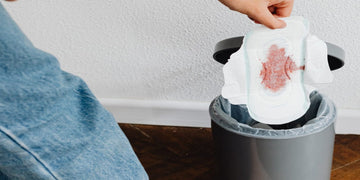
Picture this. You’re on your period and you need to change your pad, liner or tampon. You’re in the bathroom, you’ve changed into a fresh one and you need to dispose of the used pad, liner or tampon. How do you do it?
Some people would wrap the used product in the wrapper of the fresh pad or in an old newspaper - but is that enough? When we menstruate, we need to make sure that we act responsibly while disposing of used pads, liners and tampons. We are not just responsible for the environment, we also need to be socially responsible while disposing of used sanitary hygiene products.
Let’s understand how you can be socially responsible while disposing sanitary hygiene products.
Increase visibility
Imagine what would happen if you came into work and a used sanitary hygiene product was sitting at your desk. Not a pleasant sight, right? This isn’t something you’d want to deal with, so why should a sanitary worker have to deal with the same? They are human too and they have enough on their plate. They shouldn’t have to deal with sorting sanitary waste that is covered in blood. So what can you do to be a little more considerate? For starters, make sure you wrap your used sanitary hygiene product in a newspaper and use a marker or highlighter pen to make a large red dot on the newspaper to indicate what is inside the paper. This small gesture will alert the person sorting the waste and they will know how to dispose of it in the correct way.
Sort it correctly
Do you think sanitary hygiene products fall under wet waste or dry waste? The answer is neither. Sanitary hygiene products are not food or other consumables so they are not wet waste. But they aren’t dry waste either. They fall under the category of biohazard waste - so you need to dispose of them separately. A good idea would be to collect used sanitary hygiene products in the week of your period and dispose of them at the end of the week. Since they are wrapped in newspapers, they won’t stink up your home.
Now let’s talk about being environmentally responsible while disposing of used sanitary hygiene products.
It’s common knowledge that pads, tampons and liners are generally dipped in bleach - that’s why the bright white colour. That’s not natural, that’s actually harmful - to both you and the environment. Similarly, pads and liners using gel technology turn your blood flow into gel - this doesn’t break down for years and years. Finally, most pads and liners are coated with plastic - we already know plastic doesn’t degrade and can be around for centuries.
On an average, a person will use close to 16,000 pads or tampons or liners collectively in their lifetime - that’s roughly 7 billion tampons or pads or liners in sewage systems and landfills each year. Can we really afford to choose convenience over care for our environment?
One of the reasons why LemmeBe came into existence is the fact that our team bonded over their concern for the environment. We may not realise it, but non biodegradable products present in our tampons, pads, liners and other menstrual hygiene products can choke this planet. We are doing our bit by making menstrual hygiene products that will be safe for both you and our planet. You can do your bit by switching to environment friendly products that won’t choke the planet in the long run. Make better choices. Period.




